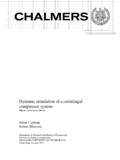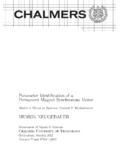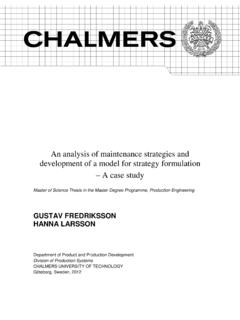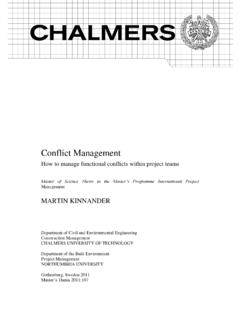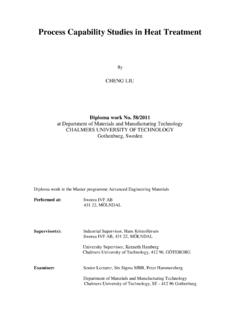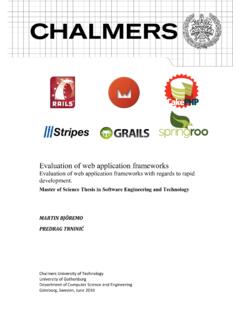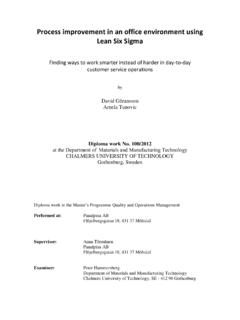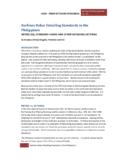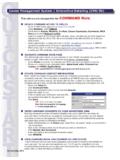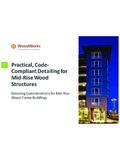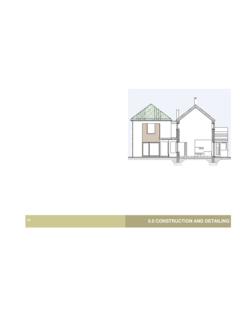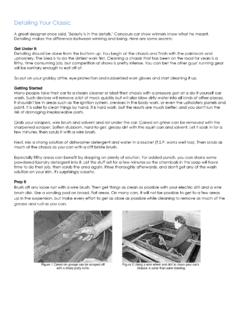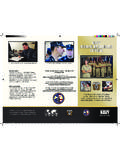Transcription of b) c) - Chalmers Publication Library (CPL)
1 Guidelines and Rules for detailing of Reinforcement in Concrete Structures A Compilation and Evaluation of Ambiguities in Eurocode 2 Master of Science Thesis in the Master s Programme Structural Engineering and Building Technology ANNELI DAHLGREN LOUISE SVENSSON Department of Civil and Environmental Engineering Division of Structural Engineering Concrete Structures Chalmers UNIVERSITY OF TECHNOLOGY G teborg, Sweden 2013 Master s Thesis 2013:142 a) h) d) g) f) e) c) b) MASTER S THESIS 2013:142 Guidelines and Rules for detailing of Reinforcement in Concrete Structures A Compilation and Evaluation of Ambiguities in Eurocode 2 Master of Science Thesis in the Master s Programme Structural Engineering and Building Technology ANNELI DAHLGREN LOUISE SVENSSON Department of Civil and Environmental Engineering Division of Structural Engineering Concrete Structures Chalmers UNIVERSITY OF TECHNOLOGY G teborg, Sweden 2013 Guidelines and Rules for detailing of Reinforcement in Concrete Structures A Compilation and Evaluation of Ambiguities in Eurocode 2 Master of Science Thesis in the Master s Programme Structural Engineering and Building Technology ANNELI DAHLGREN LOUISE SVENSSON ANNELI DAHLGREN & LOUISE SVENSSON, 2013 Examensarbete / Institutionen f r bygg- och milj teknik, Chalmers tekniska h gskola 2013.
2 142 Department of Civil and Environmental Engineering Division of Structural Engineering Concrete Structures Chalmers University of Technology SE-412 96 G teborg Sweden Telephone: + 46 (0)31-772 1000 Cover: Different configurations of links used as shear or torsional reinforcement in concrete structures. Chalmers Reproservice G teborg, Sweden 2013 I Guidelines and Rules for detailing of Reinforcement in Concrete Structures A Compilation and Evaluation of Ambiguities in Eurocode 2 Master of Science Thesis in the Master s Programme Structural Engineering and Building Technology ANNELI DAHLGREN LOUISE SVENSSON Department of Civil and Environmental Engineering Division of Structural Engineering Concrete Structures Chalmers University of Technology ABSTRACT A proper detailing of reinforcement in concrete structures is very important with regard to structural behaviour, safety and good performance.
3 However, rules in codes for detailing and minimum reinforcement ratios are not always easy to understand and interpret, since there is very limited or no background information explaining the function and providing motivations. The aim of this project was to investigate and explain the background for the rules in the codes, especially Eurocode 2, and give guidelines for good detailing , based on previous research and experience. Rules and guidelines for detailing of reinforcement that might be difficult to interpret or understand were identified by an initial study of the European Standard. From this study the background to some of the ambiguities were examined more thoroughly in a detailed literature study. An investigation consisting of interviews and a qualitative survey was performed in order to evaluate how structural engineers interprets and applies the rules provided in Eurocode 2.
4 This was performed also with the intention to illuminate ambiguities to be able to suggest improvements of the new standard. The literature study showed that there is very limited background information to Eurocode 2 and that it can be difficult to find answer, if something is perceived as unclear in the code. However, knowledge about the fundamental theory and required structural behaviour of reinforced concrete structures can be enough to understand many requirements, why this is provided in this report. The result from the investigation indicated that there are sections in Eurocode 2 that can be difficult to interpret. The standard needs to be improved or clarified in order to facilitate for the users and in order to know how to apply the rules on cases other than standard cases. Some of the identified problem areas in Eurocode 2 are for instance lapping of longitudinal reinforcement, concrete frame corners subjected to opening moment and limitations of crack widths for concrete members subjected to shear and torsion.
5 In some cases, specific changes of Eurocode 2 have been suggested, while it in some cases is sufficient to add even stronger references between sections or include a short description of the motive for the intended rule, in order to improve the standard. A need for further research has also been identified in order to be able to improve certain parts of Eurocode 2. Key words: Eurocode 2, EN 1992-1-1, Reinforcement, Reinforced concrete, detailing II Riktlinjer och regler f r detaljutformning av armering i betongkonstruktioner En sammanst llning och utv rdering av oklarheter i Eurokod 2 Examensarbete inom mastersprogrammet Structural Engineering and Building Technology ANNELI DAHLGREN LOUISE SVENSSON Institutionen f r bygg- och milj teknik Avdelningen f r konstruktionsteknik Betongbyggnad Chalmers tekniska h gskola SAMMANFATTNING God detaljutformning av armering i betongkonstruktioner r v ldigt viktigt med h nsyn till s kerhet, funktion och verkningss tt.
6 Trots detta r regler f r detaljutformning och minimiarmering inte alltid s l tta att f rst och tolka eftersom det finns v ldigt begr nsad, om ens n gon, bakgrundsinformation som f rklarar funktionen och ger motiv f r reglerna. M let med projektet var att unders ka och f rklara bakgrunden f r reglerna i standarderna, s rskilt Eurokod 2, och ge riktlinjer f r god detaljutformning, baserad p tidigare forskning och erfarenhet Regler och riktlinjer f r detaljutformning av armering som kan vara sv ra att tolka eller f rst identifierades i en inledande studie av den europeiska standarden. Utifr n denna studie utforskades d refter bakgrunden till n gra av sv righeterna i en mer ing ende litteraturstudie. En unders kning innefattande intervjuer och en kvalitativ enk tunders kning utf rdes f r att utreda hur konstrukt rer tolkar och till mpar regler som finns i Eurokod 2.
7 Detta gjordes ocks med avsikten att ytterligare kunna belysa problemomr den och komma med f rslag till f rb ttringar av den nya standarden. Litteraturstudien visade p att det finns mycket begr nsad bakgrundsinformation till Eurokod 2 och att det kan vara sv rt att finna svar om n got uppfattas som oklart i normen. Dock kan kunskap om grundl ggande teori och erforderligt verkningss tt hos armerade betongkonstruktioner r cka f r att f rst m nga av reglerna, varf r detta ges i denna rapport. Resultatet fr n unders kningen indikerar att det finns avsnitt i Eurokod 2 som kan vara sv ra att tolka. Standarden beh ver f rb ttras eller f rtydligas f r att underl tta f r dess anv ndare och f r att veta hur regler ska till mpas i situationer som inte medf r standardl sningar. N gra exempel p identifierade problemomr den i Eurokod 2 r omlottskarvning av l ngsg ende armering, ramh rn utsatta f r ppnande moment samt ber kning av sprickbredd f r betongelement som belastas av b de tv rkraft och vridning.
8 Konkreta ndringar av Eurokod 2 har f reslagits medan det i andra fall r cker med tydligare h nvisningar mellan avsnitten eller en kort f rklaring av motivet f r den avsedda regeln. Ett behov av mer ing ende forskning har ocks identifierats f r att kunna f rb ttra vissa delar av Eurokod 2. Nyckelord: Eurokod 2, EN 1992-1-1, armering, armerad betong, detaljutformning Chalmers , Civil and Environmental Engineering, Master s Thesis 2013:142 III Contents ABSTRACT I SAMMANFATTNING II CONTENTS III PREFACE IX ABBREVIATIONS AND TRANSLATIONS X NOTATIONS XI 1 INTRODUCTION 1 Background 1 Aim 1 Method 2 Limitations 3 Outline of the thesis 4 2 DEVELOPMENT OF STANDARDS FOR DESIGN OF CONCRETE STRUCTURES 5 Transition to the European Standards 5 Development of European Standards - Eurocodes 5 Development of Standards for design of concrete - Eurocode 2 6 Codes for design of concrete in Sweden 7 Additional information to the Swedish Standards 8 Consequences due to poor detailing 8 General 8 Alvik s Bridge and Gr ndal s Bridge 9 Sleipner concrete off shore platform 10 Compilation of ambiguities in Eurocode 2 12 3 REINFORCED CONCRETE STRUCTURES 18 Material properties 18 Transfer of forces between the materials 21 Bond between reinforcing
9 Steel and concrete 21 Friction 26 Shear friction at joint interface with transverse reinforcement 28 Dowel action 29 General behaviour of reinforced concrete structures 31 Response 31 Modelling 32 Design based on different analysis approaches 37 General 37 Linear elastic analysis 39 Chalmers , Civil and Environmental Engineering, Master s Thesis 2013:142 IV Linear elastic analysis with limited redistribution 39 Plastic analysis 40 Non-linear analysis 40 Strut and tie method 41 4 DESIGN AND detailing FOR BENDING 45 Structural response and modelling 45 Minimum longitudinal reinforcement 48 Requirements in Eurocode 2 48 Explanation and derivation 49 Discussion 50 Maximum longitudinal reinforcement 52 Requirements in Eurocode 2 52 Explanation and derivation 53 Discussion 54 Reinforcement detailing for concrete frame corners 57 Requirements in Eurocode 2 57 Explanation and derivation 59 Discussion 65 5 DESIGN AND detailing FOR SHEAR 70 Structural response and modelling 70 Shear sliding failure 73 Requirements in Eurocode 2 73 Explanation and derivation 73 Discussion 75 Web shear compression failure 76 Requirements in Eurocode 2 76 Explanation and
10 Derivation 77 Discussion 79 Minimum shear reinforcement 81 Requirements in Eurocode 2 81 Explanation and derivation 82 Discussion 83 Additional tensile force due to inclined cracks 86 Requirements in Eurocode 2 86 Explanation and derivation 86 Discussion 88 Configurations of shear reinforcement 91 Requirements in EC2 91 Explanation and derivation 92 Discussion 93 Load close to supports 98 Requirements in Eurocode 2 98 Chalmers , Civil and Environmental Engineering, Master s Thesis 2013:142 V Explanation and derivation 99 Discussion 101 Suspension reinforcement 103 Requirements in Eurocode 2 103 Explanation and derivation 103 Discussion 105 6 DESIGN AND detailing FOR TORSION 110 Structural response and modelling 110 Longitudinal torsional reinforcement 112 Requirements in Eurocode 2 112 Explanation and derivation 113 Discussion 116 Transversal torsional reinforcement 117 Requirements in Eurocode 2 117 Explanation and derivation 119 Discussion 122 Combination of torsional moment and shear force 123 Requirements in Eurocode 2 123 Explanation and derivation 124 Discussion 126 Configuration of transversal torsional reinforcement 128 Requirements in Eurocode 2 128 Explanation and derivation 129 Discussion 129 7 SHEAR BETWEEN WEB AND FLANGES 133 Structural response and modelling 133

